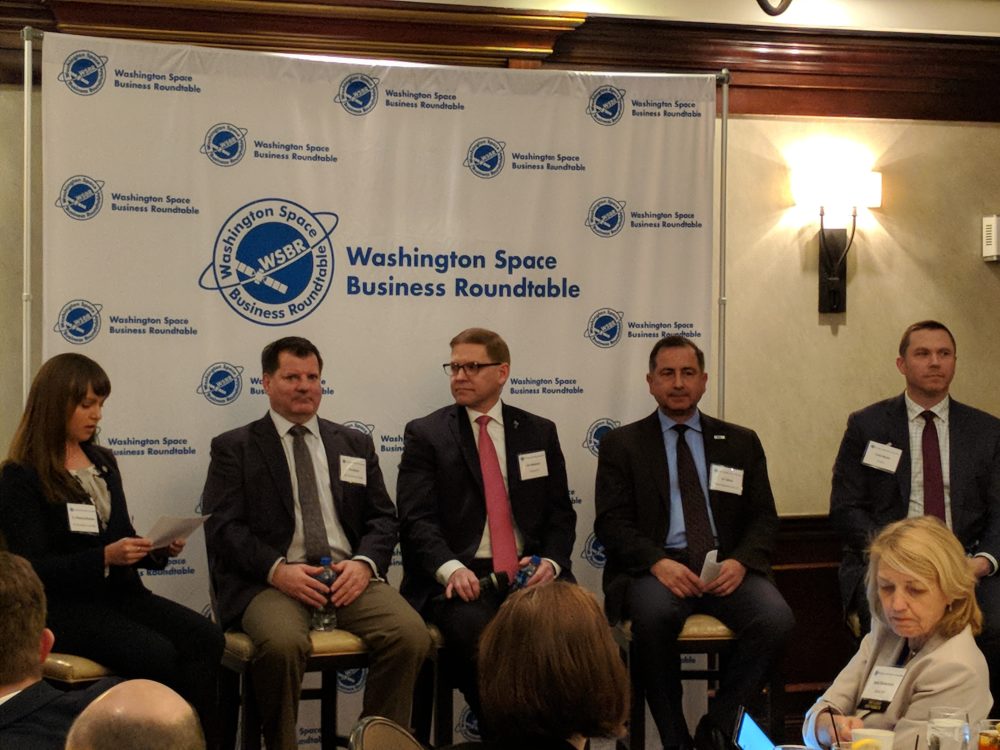Last week, the Washington Space Business Roundtable, a leadership forum comprised of the National Capital area’s satellite and space industry professionals and organizations, sponsored a panel discussion on a very interesting and innovative topic – the on-orbit servicing of satellites.
The panel discussion featured a veritable “who’s who” of space industry and government experts, including:
- Rebecca Reesman, a member of the technical staff at the Aerospace Corporation
- Tim Deaver, the Corporate Vice President of Development at SES Space and Defense
- Todd Master, the Program Manager of the Tactical Technology Office at DARPA
- Al Tadros, the Vice President of Civil and DoD Business at SSL
- Joe Anderson, the Director of Mission Extension Vehicle Services at Orbital ATK
This group of experts was assembled because they all are either driving on-orbit servicing, or will ultimately benefit from it. During their sometimes intense and overall riveting conversation, they defined on-orbit servicing, looked at the ways it can help the commercial satellite industry and even delved into the future technologies that could evolve and emerge from early on-orbit servicing solutions.
Based on the discussion between these individuals, it’s becoming increasingly clear that on-orbit servicing could be right around the corner and it could be an exciting and important new industry in space. So let’s explore how it works, and why it’s so exciting.
The “how” of on-orbit servicing
The concept of having commercial on-orbit servicing of satellites isn’t necessarily a new one – it’s something that the industry has flirted with for a while. However, it’s only now starting to look like a reality and less like science fiction.
There are obvious restrictions on what humans can do in space, but robots are not bound to those limitations, and advancements in robotics are just one of the multiple new technologies driving on-orbit servicing forward.
If you couple new innovations in robotics with new propulsion technologies, the evolution of advanced sensors and other advancements, and the concept of having a robot service a satellite in space suddenly seams surprisingly feasible.

Al Tadros summed this up well during the panel discussion when he said, “There were definitely some key technologies that evolved over the last ten years that are critical to satellite servicing…Robotics…is advancing quite a bit…making it not such a stretch of the imagination to do satellite servicing. There’s a number of elements that have culminated to make it not only technically feasible, but also economically feasible to do commercial satellite servicing.”
What we now have is a culmination and coming together of multiple exciting technologies and advancements that are making it completely possible to approach, interact with and service a satellite that has been built and launched into orbit. Commercial space companies are looking to make this a service that they offer to the government and commercial satellite operators.
So, that explains how on-orbit servicing is becoming a reality, but why? Just because we can do something doesn’t mean we should – or that there’s a demand for it. However, in this instance, the demand could be far greater than some would imagine – especially among COMSATCOM operators.
The “why” of on-orbit servicing
To this day, once a satellite is in orbit, there’s currently no feasible way to make repairs to it. Should an anomaly arise, there really is no recourse for the satellite operator.
Aside from the repair issue, there’s also the issue of fuel. Perfectly good, functioning satellites often reach their end of life simply because they run out of fuel and have to be decommissioned.
The concept of on-orbit servicing could – in theory – fix all of that. Utilizing advanced robotics to conduct operations in space that a human simply can’t. Satellites could be repaired or refueled to help extend their life. This is a proposition that’s clearly exciting for commercial satellite operators because it gives them the ability to reduce or mitigate the losses from anomalies, while also prolonging the life of exceptionally expensive spacecraft that are already in orbit.
This point was reinforced by Tim Deaver during the panel discussion, when he said, “If a satellite program is going to cost us $300M to get up into orbit and it’s only going to last us 15 years, that’s about $20M a year in costs. If I can refuel it and get three more years for a reasonable cost…it makes economic sense.”
It’s going to make even more economic sense for commercial operators in the near future. The trend towards HTS satellites and the sheer numbers of “birds” in the sky has led to a decrease in bandwidth costs, as an influx of capacity has hit the market. As the cost for capacity decreases, it becomes even more essential for operators to maximize the life – and subsequently the revenue generated – from every satellite they launch.
As Tim said, “For us it’s about making sense in the marketplace. As we see the downturn in the price of capacity onboard and the revenue that we can generate from a satellite, it becomes about how do we get cheaper satellites, how do we get cheaper launch, and what can we do to satellites that are up in orbit that are still working well, but are getting to the end of [their] fuel life.”
It’s for this reason that Tim claims SES will be one of the first customers for Robotic Servicing of Geosynchronous Satellites (RSGS) when it’s available.
However, the commercial industry isn’t the only group interested in on-orbit servicing of satellites. There are tremendous government and military use cases and opportunities for this technology. In our next article on the Government Satellite Report, we’ll delve into the reasons why the military is excited about this solution, and the unique future capabilities it could enable.
